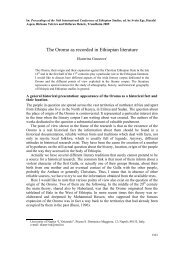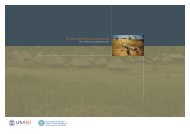Create successful ePaper yourself
Turn your PDF publications into a flip-book with our unique Google optimized e-Paper software.
138 Ethiop.J.Health Dev.<br />
______________________________________________________________________________________<br />
BTB, prevalence of BTB in humans, productivity<br />
parameters in cattle, cost of animal and animal products<br />
(regional, seasonal and annual variation), cost of TB in<br />
birth<br />
mortality<br />
birth<br />
mortality<br />
Susceptible<br />
cattle X<br />
Susceptible<br />
Humans A<br />
infected cattle<br />
Cattle to human<br />
transmission<br />
Infected<br />
cattle Y (IDT<br />
positive)<br />
humans, risk factors of disease transmission and socioanthropological<br />
parameters.<br />
Figure 1: Adapted model framework for joint human-animal BTB transmission in Ethiopia<br />
Demographic data (birth and mortality rate) in both<br />
humans and cattle are obtained from national statistics. In<br />
addition, cattle demographic data are collected from a<br />
four year productivity study, which follows 700 cattle in<br />
21 farms, as well as from a herd structure analysis carried<br />
out in the sites where cattle PPD is performed.<br />
The burden of disease will be assessed for the livestock<br />
sector using BTB prevalence found in the field and in the<br />
abattoirs as well as from the impact on their productivity.<br />
The burden for the public health sector will be assessed<br />
in terms of prevalence of disease in humans, cost of the<br />
disease and DALY. Data on cost of the disease will be<br />
collected directly in hospitals and health centers as well<br />
as through a patient based household survey. Data<br />
includes out and in-patient costs, therapy costs, loss of<br />
income and coping costs.<br />
Benefits of an intervention will be computed for three<br />
different sectors:<br />
1. The agricultural sector: the benefit resulting from the<br />
avoided losses in animals and animal products.<br />
2. The public health sector: the benefit resulting from the<br />
avoided costs to the public health sector.<br />
3. Private households with patients suffering from TB:<br />
the benefit resulting from (i) avoiding payment for<br />
treatment, (ii) income loss (= opportunity costs), and (iii)<br />
coping costs.<br />
mortality<br />
cull<br />
BCG vaccination<br />
Reported patient with<br />
clinical tuberculosis<br />
due to M. bovis B<br />
mortality mortality<br />
Immunised<br />
cattle Z<br />
mortality<br />
Immunised<br />
humans C<br />
The sum of all three benefits will be considered as a<br />
benefit for the society as a whole.<br />
Discussion<br />
The disease has been shown in many countries to be an<br />
economical and financial burden to society due to<br />
economic losses: loss of productivity of infected animals<br />
(e.g. reduced milk yields and meat production), animal<br />
market restrictions, human health costs etc.<br />
In Argentina, the annual loss due to BTB is<br />
approximately US$63 million (4). The socio-economic<br />
impact of BTB to the agriculture and health sector in<br />
Turkey has been estimated at between 15 and 59 million<br />
US$ per year (8). Even in some industrialized countries,<br />
where BTB has been eradicated by expensive schemes<br />
for control, eradication and compensation for farmers, the<br />
disease still has a major economic impact, mainly due to<br />
the existence of a permanent wildlife reservoir that<br />
reduces the efficiency of control strategies. In the UK,<br />
where badger and other wildlife such as deer remain an<br />
important source of infection for livestock,<br />
approximately £100 million is spent annually in efforts to<br />
control the disease. In Africa, the economic losses<br />
associated with livestock infected with BTB have not<br />
been examined sufficiently or have not been studied at all<br />
(9). Since agriculture remains the backbone of many<br />
Ethiop.J.Health Dev. <strong>2008</strong>;22(Special Issue)







